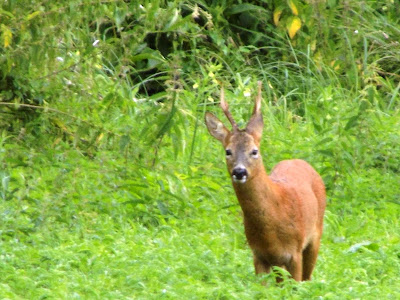This is a riband wave which is a common species in the UK though it is late in the year to be seeing it- it might well be a second brood. They are night flyers though so you don't usually see them as clearly as this.
Another moth I spotted recently was this one, which wasn't keen on having it's photograph taken and kept trying to hide among the brambles.
This one is a mother of pearl, the name coming from the rainbow-like lustre the wings produce under the right light. Moths are classed as either macro (big) or micro (small) and oddly this is a micro moth, despite being larger than many macro moths. The larvae feed on nettles which is likely why I saw several of these amongst the brambles.
I visited Blashford Lakes this week and got really clear views of a family of black-headed gull chicks.
You can see how well camouflaged they are against the gravel shore. Black-headed gulls are of course very common birds and seen inland over most of the UK but it hasn't always been so. 100 years ago they were fairly rare, especially inland, but now there this is a breeding population of over 100,000 pairs. It's likely this rise is due to how well they live alongside humans, as happy to eat human leftovers as they are to eat insects and plants.
Another bird spot at Blashford was this one:
Whilst I can't be certain from this low quality image, this is probably a reed warbler. This tree is right on the edge of a large areas of reeds- this is a species that sticks to the habitat in it's name. Reed warblers are migrants, coming to the UK to breed in the summer and over-wintering in Sub-Saharan Africa. They are one of the main host birds for cuckoos.
Only a few steps away from this warbler was this really striking insect.
This is a four-banded longhorn beetle (say what you see!). It's a fairly common species but the adults don't live for very long so it's not seen as often as the numbers would suggest.
A rabbit had a good look at me as I approached in the same area too:
Another mammal sighting this week was of a roe deer buck.
This individual has sizeable antlers for a roe deer so is clearly a well-developed adult. It was also seen in the same place as the doe and two fawns I saw last week so it's highly likely that this is the father. Roe deer are territorial but male and female territories do overlap- it's unlikely any other males have entered this area to breed with the female with this guy around.
Finally for today, I was stood only about four metres from the bird table when a flock (or 'volery') of long-tailed tits arrived.
I counted eight on the feeders at once and it's likely there were more in the area- long-tailed tit groups usually have about twenty birds in them. They are particularly social birds and often help each other in bringing up young if their own nests fail. A study suggested that as many as half of long-tailed tit nests had one or more helpers to feed the young.
I shall be back for more at the weekend where amongst other things I'll be discussing the weird world of oak galls...













No comments:
Post a Comment